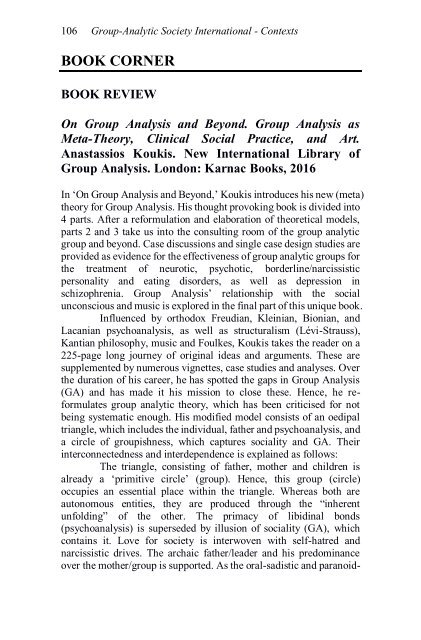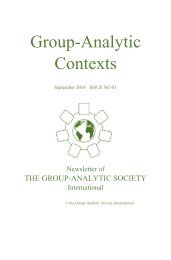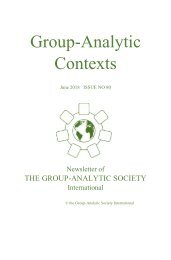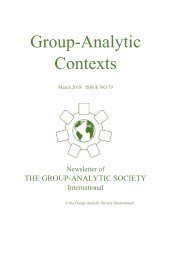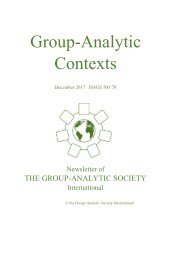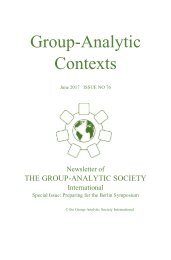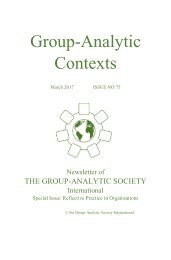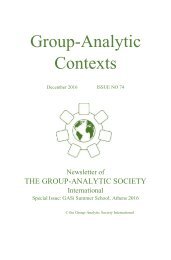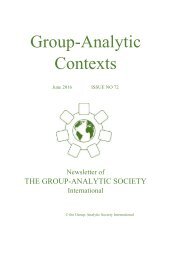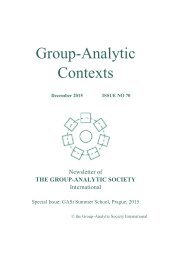Group Analytic Contexts, Issue 77, September 2017
Newsletter of the Group Analytic Society International
Newsletter of the Group Analytic Society International
You also want an ePaper? Increase the reach of your titles
YUMPU automatically turns print PDFs into web optimized ePapers that Google loves.
106 <strong>Group</strong>-<strong>Analytic</strong> Society International - <strong>Contexts</strong><br />
BOOK CORNER<br />
BOOK REVIEW<br />
On <strong>Group</strong> Analysis and Beyond. <strong>Group</strong> Analysis as<br />
Meta-Theory, Clinical Social Practice, and Art.<br />
Anastassios Koukis. New International Library of<br />
<strong>Group</strong> Analysis. London: Karnac Books, 2016<br />
In ‘On <strong>Group</strong> Analysis and Beyond,’ Koukis introduces his new (meta)<br />
theory for <strong>Group</strong> Analysis. His thought provoking book is divided into<br />
4 parts. After a reformulation and elaboration of theoretical models,<br />
parts 2 and 3 take us into the consulting room of the group analytic<br />
group and beyond. Case discussions and single case design studies are<br />
provided as evidence for the effectiveness of group analytic groups for<br />
the treatment of neurotic, psychotic, borderline/narcissistic<br />
personality and eating disorders, as well as depression in<br />
schizophrenia. <strong>Group</strong> Analysis’ relationship with the social<br />
unconscious and music is explored in the final part of this unique book.<br />
Influenced by orthodox Freudian, Kleinian, Bionian, and<br />
Lacanian psychoanalysis, as well as structuralism (Lévi-Strauss),<br />
Kantian philosophy, music and Foulkes, Koukis takes the reader on a<br />
225-page long journey of original ideas and arguments. These are<br />
supplemented by numerous vignettes, case studies and analyses. Over<br />
the duration of his career, he has spotted the gaps in <strong>Group</strong> Analysis<br />
(GA) and has made it his mission to close these. Hence, he reformulates<br />
group analytic theory, which has been criticised for not<br />
being systematic enough. His modified model consists of an oedipal<br />
triangle, which includes the individual, father and psychoanalysis, and<br />
a circle of groupishness, which captures sociality and GA. Their<br />
interconnectedness and interdependence is explained as follows:<br />
The triangle, consisting of father, mother and children is<br />
already a ‘primitive circle’ (group). Hence, this group (circle)<br />
occupies an essential place within the triangle. Whereas both are<br />
autonomous entities, they are produced through the “inherent<br />
unfolding” of the other. The primacy of libidinal bonds<br />
(psychoanalysis) is superseded by illusion of sociality (GA), which<br />
contains it. Love for society is interwoven with self-hatred and<br />
narcissistic drives. The archaic father/leader and his predominance<br />
over the mother/group is supported. As the oral-sadistic and paranoid-


